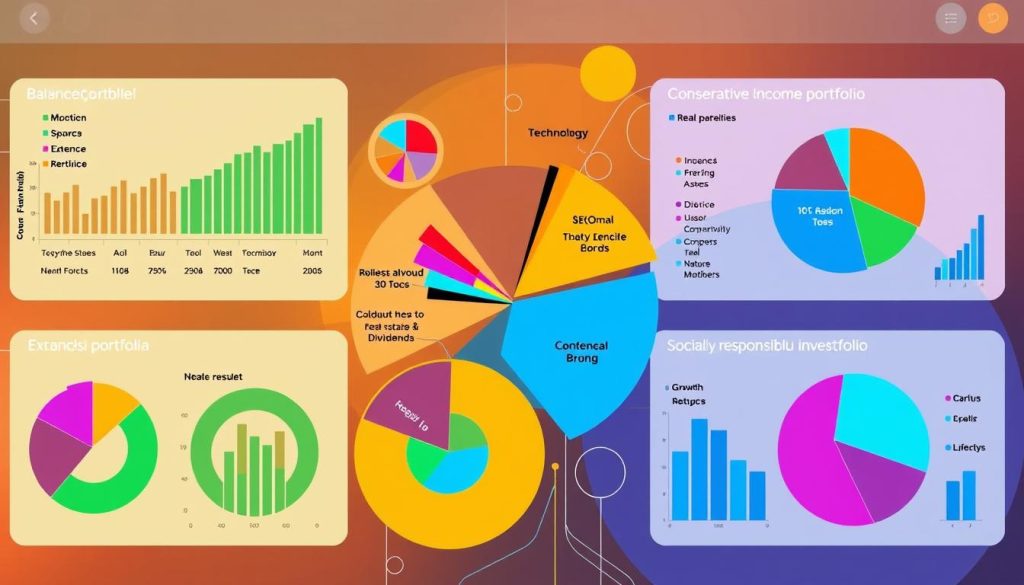Investing can seem overwhelming, but with the right approach, you can create a portfolio that meets your financial goals. Whether you aim to grow your wealth, secure your retirement, or diversify your assets, this guide will help. It will teach you how to make smart investment decisions and reach your financial dreams.
The Great Recession showed us how volatile the stock market can be. In just 14 months, the market plummeted1. After the crisis, most active fund managers failed to beat their benchmarks1. These events highlight the need for portfolio management and financial planning expertise. With the right knowledge and a financial advisor’s help, you can develop a wealth management plan that withstands market ups and downs.
This article will share the secrets of investment advisory. You’ll learn how to create a portfolio that fits your financial needs and risk level. From understanding portfolio types to mastering portfolio management, you’ll gain the skills to navigate the investment world and secure your financial future.
Key Takeaways
- Understand the principles of successful portfolio management to build a winning investment strategy.
- Leverage the expertise of financial advisors to make informed decisions and achieve your financial goals.
- Explore different types of portfolios and investment strategies to find the right fit for your unique needs.
- Learn how to effectively monitor and rebalance your portfolio to adapt to changing market conditions.
- Discover the benefits of professional guidance and how to choose the right financial advisor for your needs.
Understanding Portfolio Management
Portfolio management is about picking, keeping, and checking on a group of investments. It aims to meet an investor’s financial goals2. It’s about making smart choices about what investments to have, matching them with goals, and balancing risk and performance2.
Definition and Scope
Portfolio management means managing an investor’s money by mixing different investments like stocks, bonds, and real estate2. Its main goals are to get the best returns while keeping risk low, ensuring money is easy to use, and finding the right mix of income and growth2. This is done by picking the right investments that fit the investor’s goals and how much risk they can handle2.
Objectives of Portfolio Management
The main goals of portfolio management are:
- Getting the best returns while keeping risk low2
- Keeping money easy to use and accessible2
- Finding the right mix of income and growth2
- Matching investments with the investor’s goals and risk level2
Portfolio managers work hard to build and keep a diverse investment portfolio. They consider the investor’s time frame, risk level, and financial situation2. By managing the mix of investments, they aim to grow wealth over time and ensure financial safety2.
| Key Aspects of Portfolio Management | Description |
|---|---|
| Investment Mix and Policy | Determining the right mix of assets like stocks, bonds, and real estate for the right risk-return balance. |
| Asset Allocation | Spreading investments across different asset classes and sectors to reduce risk and increase returns. |
| Risk Management | Finding, measuring, and reducing potential risks like market ups and downs, inflation, and economic changes. |
| Performance Monitoring | Checking the portfolio’s performance often and making changes to keep it in line with the investor’s goals and risk level. |
Portfolio management is a continuous process that needs ongoing checks, rebalancing, and adjustments. It’s to keep up with market changes and the investor’s changing needs2. By staying alert and making smart choices, portfolio managers help investors through the complex financial world and towards their long-term goals2.
Types of Portfolios
There are three main types of portfolios: aggressive, conservative, and balanced. Each one fits different risk levels and goals. This lets investors match their portfolios to their financial needs and comfort with risk.
Aggressive Portfolio
An aggressive portfolio is for those who want high growth and are ready for more risk. It includes emerging companies, high-yield bonds, and other speculative assets3. These portfolios aim to beat the market with high alpha and beta3. But, they can be very volatile, best for those with a long-term view and can handle market ups and downs.
Conservative Portfolio
A conservative portfolio focuses on keeping your money safe and steady income over growth. It has government bonds, blue-chip stocks, and money market instruments4. These investments are less risky, with lower beta, making them good for those who want to protect their money and get a steady income.
Balanced Portfolio
A balanced portfolio aims for a mix of growth and stability. It spreads investments across stocks, bonds, and real estate5. This approach is for those who want a balance between growth and stability5. By diversifying, balanced portfolios can reduce risk and offer a more stable investment experience.
| Portfolio Type | Investment Focus | Risk Profile | Potential Return |
|---|---|---|---|
| Aggressive | Emerging companies, high-yield bonds | High risk | High growth |
| Conservative | Government bonds, blue-chip stocks | Low risk | Capital preservation |
| Balanced | Mix of stocks, bonds, and real estate | Moderate risk | Balanced growth and stability |
Knowing about these portfolio types helps investors make smart choices. It lets them match their investments to their financial goals and risk comfort. Working with a financial advisor can help create a portfolio that meets individual needs and goals.
Components of a Successful investment advisory Portfolio
Creating a winning investment portfolio means knowing how to mix asset allocation, diversification, and risk management. Asset allocation is about splitting your money into different types, like stocks, bonds, and cash. This is based on your financial goals and how much risk you can handle6. Getting this right can lead to up to 90% of your portfolio’s success over time7.
Diversification is about spreading your investments across different areas. This includes sectors, industries, and countries. It helps lower the risk of big losses from one investment7. Adding global investments can also cut down on risks from your home market and open up new growth chances abroad7.
Risk management is key in building a portfolio. It’s about spotting, evaluating, and tackling risks. This way, you can lessen their impact6. Good financial advisors put their clients first to avoid wrongdoings and legal trouble6. It’s also important to regularly check your portfolio. This keeps your wealth safe, reduces risks, and makes sure you’re paying the right amount in taxes7.
By understanding these elements, you can craft a portfolio that’s both diverse and well-managed. It will match your financial goals and help you reach your investment dreams.
Steps to Effective Portfolio Management
Creating a winning investment portfolio begins with setting clear financial goals. These goals should be SMART – specific, measurable, achievable, relevant, and time-bound. Whether you’re saving for retirement, a home, or your child’s education, clear goals guide your investment choices8.
Understanding your risk tolerance is also key. This is how much market volatility you can handle. Your age, income, investment experience, and financial obligations all play a role in your risk tolerance8.
Regular Monitoring and Rebalancing
It’s vital to regularly review and rebalance your portfolio. Rebalancing means adjusting the mix of stocks, bonds, and cash to match your risk and return goals. This keeps your portfolio in line with your original strategy8.
| Risk Tolerance | Stocks | Bonds | Cash | Alternative Investments |
|---|---|---|---|---|
| Conservative | 30% | 50% | 15% | 5% |
| Moderate | 60% | 30% | 5% | 5% |
| Aggressive | 80% | 10% | 5% | 5% |
By keeping a close eye on your portfolio and making adjustments, you can keep it in line with your financial goals and risk tolerance. This is important throughout your investment journey8.
“Successful portfolio management is an ongoing process, not a one-time event. Regular monitoring and adjustments are key to keeping your investments on track.”
Investment Strategies
Building a successful investment portfolio means knowing the different strategies. You might aim for growth investing, value investing, or income investing. Each has its own benefits and fits different financial goals.
Growth Investing
Growth investing looks for companies that can grow a lot. These stocks might be riskier, but they could offer big gains for those looking to grow their money over time9.
Value Investing
Value investing finds undervalued companies with good chances for growth. It’s about finding stocks that are cheaper than they should be. This way, investors can find hidden opportunities10.
Income Investing
Income investing focuses on making regular income from things like bonds, dividend-paying stocks, and REITs. It’s great for those wanting steady income or extra cash10.
Creating a portfolio that fits your goals and risk level is tricky. Getting help from a financial advisor can make it easier. They can help tailor a plan that meets your specific needs10.
| Investment Strategy | Focus | Risk Profile | Potential Rewards |
|---|---|---|---|
| Growth Investing | Companies with above-average growth | Higher risk | Capital appreciation |
| Value Investing | Undervalued companies with strong fundamentals | Moderate risk | Long-term growth |
| Income Investing | Bonds, dividend-paying stocks, REITs | Lower risk | Regular income |
“Successful investing is about managing risk, not avoiding it.” – Benjamin Graham, the father of value investing.
The Role of Financial Advisors
Working with a financial advisor can greatly improve your financial management. They are skilled in managing portfolios, giving investment advice, and reducing risks. This expert guidance is crucial for navigating the complex world of personal finance11.
Benefits of Professional Guidance
Financial advisors offer deep insights into market trends and asset allocation. They help set financial goals, assess risk tolerance, and create a tailored investment plan. This plan is designed to fit your specific needs and long-term goals12.
They also keep you focused during market ups and downs. Advisors help you avoid making rash decisions and keep your eyes on the long-term financial prize. They provide valuable advice on retirement, taxes, and estate planning. This ensures your wealth is safe and well-managed for your family12.
How to Choose the Right Advisor
Choosing the right financial advisor is key. Look at their qualifications, experience, fees, and if they act in your best interest. Choose someone who is open about their fees and has a history of helping clients reach their financial goals11.
Talk openly with potential advisors to see if they fit your needs. The right advisor is a trusted partner on your path to financial security and success12.
Conclusion
Managing a portfolio well is a dynamic process. It needs a strategic and informed approach. By understanding key principles, using the right strategies, and managing risk, you can build a strong portfolio. This portfolio can handle market changes and help you reach your long-term goals13.
Financial advisors play a big role in this journey. They offer valuable guidance, using their knowledge and insights to help you. When picking a financial advisor, look at their qualifications, fees, and if they match your investment views13.
Choosing between a traditional advisor or an OCIO solution is important. Consider customization, control, fees, governance, and performance to match your needs and goals14. By staying informed, adaptable, and working with your advisor, you can create a portfolio that meets your needs and manages risk well13.
FAQ
What is portfolio management?
What are the primary objectives of portfolio management?
What are the different types of investment portfolios?
What are the key components of a successful investment portfolio?
What are the steps to effective portfolio management?
What are the main investment strategies?
What are the benefits of working with a financial advisor?
How do I choose the right financial advisor?
Source Links
- My secret weapon for better portfolio management | Investment Executive
- Portfolio Managers vs. Investment Advisors: How Do the Two Differ? – WiserAdvisor – Blog
- Portfolio Management: Definition, Types, and Strategies
- 5 Popular Portfolio Types
- Investment Portfolio
- 5 Traits of Successful Financial Advisors
- 9 Crucial Components of an Investment Portfolio Review
- The Step by Step Portfolio Planning Process
- Investment Strategy Group – our in-house think tank
- Investment Strategies & Portfolio Management Solutions
- What Does a Financial Advisor Do?
- What Does a Financial Advisor Do and Should I Get One?
- What is an Investment Advisory?
- OCIO vs Investment Consultants: Key Differences



